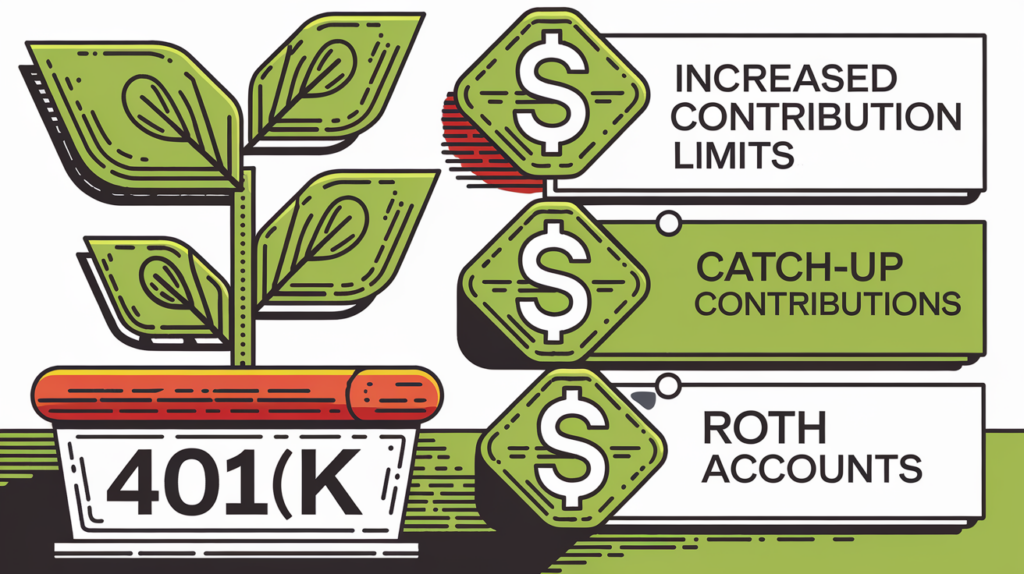Planning for retirement can be daunting, especially with frequent changes in 401(k) regulations. The upcoming adjustments in 2025, introduced under the SECURE 2.0 Act, bring new opportunities and requirements that could impact your retirement strategy significantly. At XOA TAX, we understand the importance of staying informed to make the most of your retirement savings. Here’s a breakdown of what you need to know about the 2025 401(k) changes and how they could shape your financial future.
Key Takeaways
- Contribution limits for 401(k) plans are increasing, offering more saving potential.
- New “super catch-up” contributions allow even higher savings for those aged 60-63.
- Automatic enrollment will become mandatory for new employer-sponsored plans.
- High earners will need to make Roth catch-up contributions for tax efficiency.
- Emergency savings accounts can be linked to 401(k)s for accessible savings.
- Employers can match student loan payments with retirement contributions.
Exploring the 2025 401(k) Changes in Detail
1. 2025 401(k) Changes at a Glance
| Change | Details | Benefit |
|---|---|---|
| Increased Contribution Limits | Annual contribution limit raised to $23,500. | More potential for tax-deferred growth. |
| Super Catch-Up Contributions (Age 60-63) | Additional $11,250 in catch-up contributions, totaling $34,750. | Ideal for late-career savers looking to maximize retirement savings. |
| Automatic Enrollment for New Plans | Mandatory enrollment for new plans, starting at 3% and increasing by 1% annually until reaching 10-15%. | Encourages earlier and consistent savings for employees. |
| Roth Catch-Up Contributions for High Earners | High earners ($145,000+) aged 50+ required to make catch-up contributions to Roth accounts, beginning in 2026. | Offers tax-free growth and withdrawals for high earners. |
| Emergency Savings Account | Allows up to $2,500 in annual contributions, linked to a Roth account. First four withdrawals are tax- and penalty-free. | Provides accessible funds for emergencies without tapping into core retirement savings. |
| Employer Matching for Student Loans | Employers can match student loan payments with 401(k) contributions, starting in 2024. | Enables employees with student debt to build retirement savings while repaying loans. |
2. Highlights of Key Changes
Increased Contribution Limits
Starting in 2025, the annual contribution limit for 401(k) plans will increase to $23,500, allowing employees to save more towards retirement in a tax-advantaged way. This increase also applies to catch-up contributions, allowing those aged 50 and over to potentially save even more.
Super Catch-Up Contributions for Ages 60-63
If you’re between the ages of 60 and 63, you can make an extra “super catch-up” contribution of $11,250, raising your total contribution limit to $34,750. This is an excellent opportunity for those approaching retirement to ramp up their savings.
Automatic Enrollment Requirement for New Plans
Beginning in 2025, new 401(k) plans are required to automatically enroll eligible employees, with an initial contribution of at least 3%. This rate will increase annually by 1%, capping at a maximum of 15%. Automatic enrollment helps individuals begin saving earlier and steadily increases contributions over time.
Roth Catch-Up Contributions Required for High Earners
For high earners, a new rule requires those aged 50 and older who earn more than $145,000 to make catch-up contributions to Roth accounts. This change, starting in 2026, allows for tax-free growth and withdrawals in retirement, a major benefit for those in higher tax brackets.
Emergency Savings Accounts Linked to 401(k)s
An additional change allows employees to contribute up to $2,500 to an emergency savings account connected to their 401(k). The first four withdrawals per year are penalty- and tax-free, providing flexibility for unforeseen expenses without disrupting core retirement savings.
Employer Matching for Student Loan Payments
Employers now have the option to match employee student loan payments with contributions to their retirement plans. This new provision helps those with student loans build their retirement funds without delaying student debt repayment.
Frequently Asked Questions (FAQ)
How do I know if I qualify for the new super catch-up contribution?
How do I know if I qualify for the new super catch-up contribution?: If you are between 60 and 63 in 2025 and eligible to make 401(k) contributions, you qualify. It’s a great way to increase savings right before retirement.
Why does the Roth catch-up rule apply only to high earners?
Why does the Roth catch-up rule apply only to high earners?: This rule encourages higher-income individuals to prepay taxes now, helping reduce future tax liabilities and increasing current tax revenue.
Can my current 401(k) plan be linked to an emergency savings account?
Can my current 401(k) plan be linked to an emergency savings account?: Only specific plans will offer this feature, so check with your employer’s plan administrator. At XOA TAX, we can help you evaluate your options and create a strategy that aligns with your financial needs.
How does the automatic enrollment affect my contribution flexibility?
How does the automatic enrollment affect my contribution flexibility?: You have full control over your contributions and can adjust your rate after automatic enrollment. For personalized advice on optimizing your contributions, contact us.
Need Expert Help with Your 401(k) Strategy? Connect with XOA TAX!
Understanding 401(k) changes can be complex, especially when you’re aiming to maximize your retirement while staying compliant with new rules. At XOA TAX, we specialize in guiding our clients through the intricacies of tax-advantaged retirement strategies. If you’re interested in tailored advice on 401(k) planning, contribution strategies, or Roth conversions, we’re here to help.
Get in Touch:
Website: https://www.xoatax.com/
Phone: +1 (714) 594-6986
Email: [email protected]
Contact Page: https://www.xoatax.com/contact-us/
Disclaimer: This post is for informational purposes only and does not provide legal, tax, or financial advice. Laws, regulations, and tax rates can change often, and vary significantly by state and locality. This communication is not intended to be a solicitation and XOA TAX does not provide legal advice. Please consult a professional advisor for advice specific to your situation.




 anywhere
anywhere  anytime
anytime